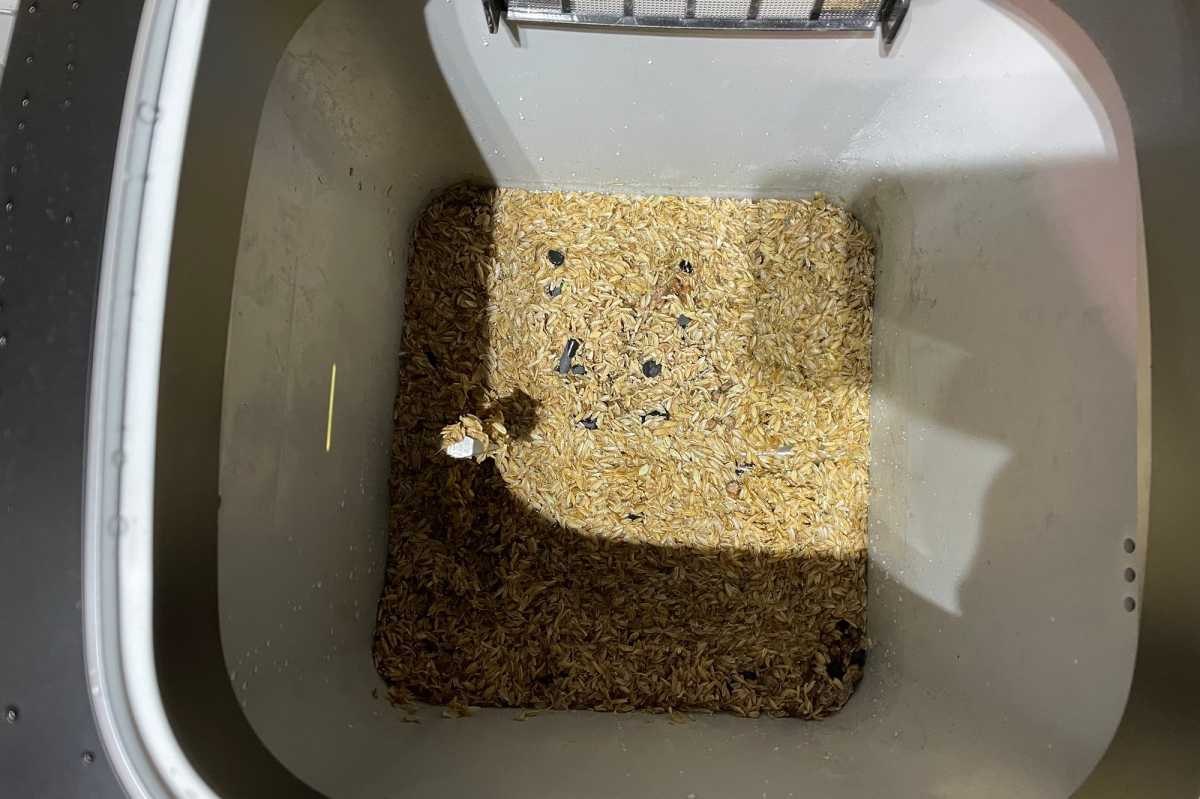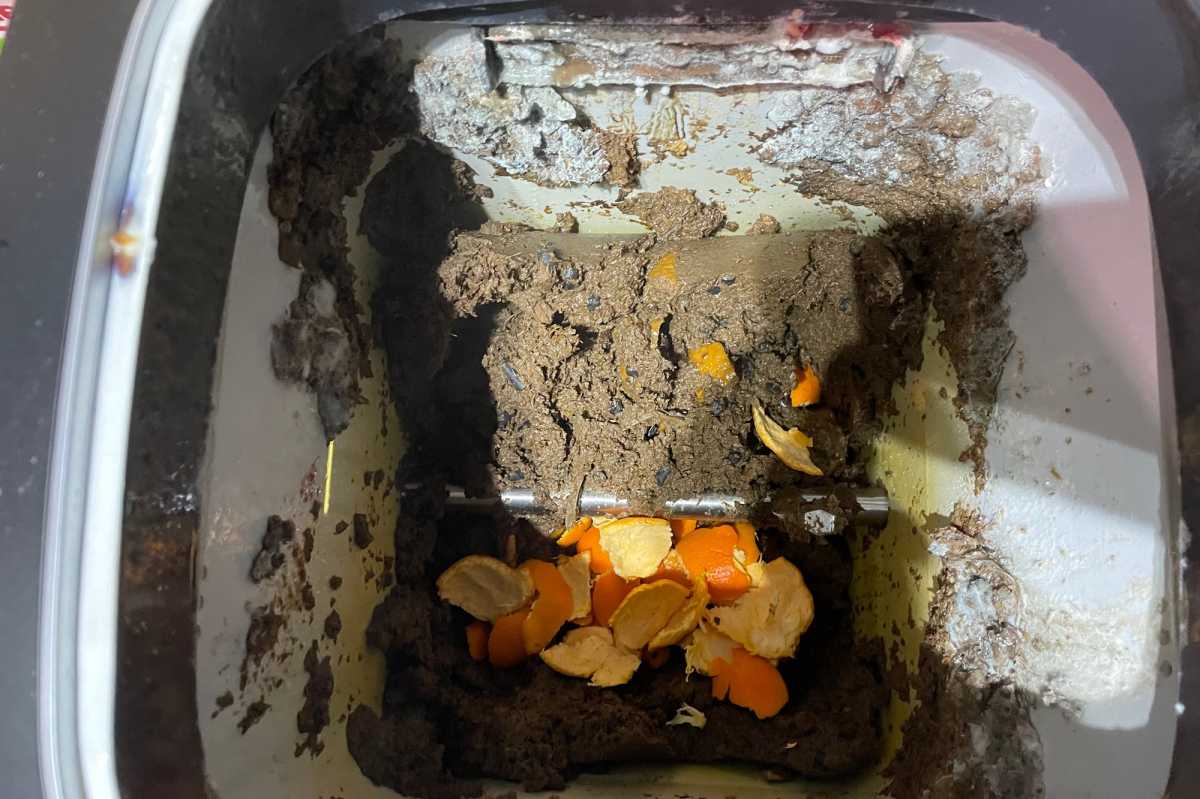At a glance
Expert’s Rating
Pros
- Transforms food waste into organic compost for your garden
- Easy to use
- Diverts food waste from the landfill
Cons
- Very expensive
- Fibrous food waste needs to be cut up
- Can’t handle all food waste
- Can be difficult to control fermentation odors
Our Verdict
This electronic composter works as promised, converting your food waste into nutritious compost you can add to your garden—or even your potted plants. But it’s very expensive, you’ll need to pre-process fibrous foods, and it can’t handle all the food waste your kitchen will generate.
Price When Reviewed
$449.00
Best Prices Today: Reencle Home Composter
Dump your food waste into the Reencle Home Composter, and in a matter of weeks, you’ll have organic compost you can use to enrich the soil in your garden or your potted plants. You’ll feel happy about doing Earth a solid while the pricey appliance’s motorized paddles and patented microorganisms quietly churn and break down your scraps and leftovers—provided you can tolerate the unit’s shortcomings.
The composter, which I first saw at CES last January, largely works as advertised. My biggest reservation about it relates to what food waste you can’t put in it. Many municipalities—and most big cities—ask residents to separate their food waste into a dedicated bin, so it can be diverted from the landfill and processed into compost instead. In my home city of Portland, Oregon, any kind of food waste—from bones to eggshells to fruit pits—goes in the bin along with my yard waste. The local waste disposal company even instructs us to put soiled napkins and cardboard pizza boxes in it.
The Reencle Home Composter is a virtuous product for environmentally conscientious consumers.
The Reencle Home Composter is much more selective. Foods like bread, oatmeal, fruit and vegetable peels, pasta, cheeses, and similarly otherwise edible foodstuffs are fine. The composter can also handle a second class of food waste, with the caveat that adding it to its stirring tank will slow down decomposition. That category includes raw vegetables, meat, coffee grounds, melon rinds, cured meats (e.g., sausage and salami), peanut butter, vegetable stems, and pizza crust. Food waste such as bones, stone-fruit pits, pineapple peels, nut and seafood shells, and even eggshells, meanwhile, are verboten.
Opening the Reencle Home Composter’s lid automatically stops its churning motion, but the manufacturer provided this GIF so you can see it in operation.
Reencle
So, composting with the Reencle isn’t a simple matter of scraping your cutting boards and plates into the bin. Instead, you’ll need to separate your food waste into at least two piles: what the appliance can handle, and what is better suited to your municipal compost bin (assuming you have that option; if you don’t, it will go in your garbage). What’s more, Reencle also recommends cutting high-fiber foods—such as orange and banana peels, celery, and melon rinds—into small pieces to aid in decomposition.
Reencle recommends limiting the amount of food waste you put in the bin to 1.5 pounds per day (optimal), but no more than 2.2 pounds per day. That hasn’t been an issue for my family, but we have encountered other issues. The biggest of these is related to what would otherwise be a convenient feature: a proximity sensor at the base of the appliance that opens the stirring tank’s lid when you move your foot near it. It automatically closes after 3 seconds, but when we were moving around our tiny kitchen (it’s less than 42 square feet), the lid was open nearly as often as it was closed. Leaving the lid open slows decomposition.

Reencle’s Decomposing Powder consists of bacteria that actively digest food waste and convert it to compost.
Michael Brown/Foundry
The composting process creates a fermentation odor that the machine’s fan, mesh filter, carbon filter, and air-purifying mode hasn’t always compensated for. (The two included carbon filters last about one year each, and replacements cost $35.) When the lid opens, these odors waft out. The smell is like what you’d encounter at a winery; as such, it’s not entirely unpleasant—if you’re at a winery. In our tiny kitchen, it was sufficiently off-putting that we soon relocated the composter to our basement.
When you encounter odors, Reencle suggest putting bread—and no other food waste—in the stirring tank for at least one to two days, turning on the machine’s Drying mode for one day, and then adding coffee-ground waste to the food waste. If you overdo it and the compost gets too dry, you’ll need to add a small amount of water to the stirring tank.
 Those are fresh orange peels on top of previously processed food waste. You’ll need to scrape mold off the Reencle Home Composter’s internal filter every few weeks. Its external carbon filter will last about a year.
Those are fresh orange peels on top of previously processed food waste. You’ll need to scrape mold off the Reencle Home Composter’s internal filter every few weeks. Its external carbon filter will last about a year.
Michael Brown/Foundry
Lest I make the appliance sound too finicky, the package of decomposing powder that does most of the work creating your compost reproduces itself in the process, so it can last almost indefinitely. Reencle says even if you deprive the bacteria of nutrients and moisture for months on end, the material will go into something like suspended animation, transforming into a spore state until you resume feeding it. That said, it is possible to kill the bacteria; in which case, a replacement bag will cost you $65.
You’ll need to “cure” the material you remove from the machine before you can add it to your garden; a plastic hand shovel hangs from the exterior side of the machine for this purpose. The curing process involves mixing one part of the material with four parts soil, and then letting it rest for at least three weeks. Reencle says finished compost will resemble dark and crumbly topsoil and that it will smell like earth.
Should you buy a Reencle Home Composter?
The Reencle Home Composter is a virtuous product for environmentally conscientious consumers who can afford its high price tag. This isn’t a gadget that will pay for itself over time, at least not in the financial sense of the word. If you have the space in your yard, it’s easy enough to start your own compost pile for free, or if you want a contained solution, you can buy a barrel composter for less than $100. If you don’t want to deal with creating compost, pre-packaged organic compost is widely available and relatively cheap.
All that said, the machine works, and my garden has been the happier for it. In addition to curing the compost and using it as a soil amendment, I’ve prepared compost tea with it and fed the nutrient-filled solution to my plants. The question I haven’t quite answered for myself is whether I am sufficiently committed to separating my food scraps, cutting the fibrous stuff into bite-sized pieces, and making daily treks to my basement to feed this thing for the rest of my life.

